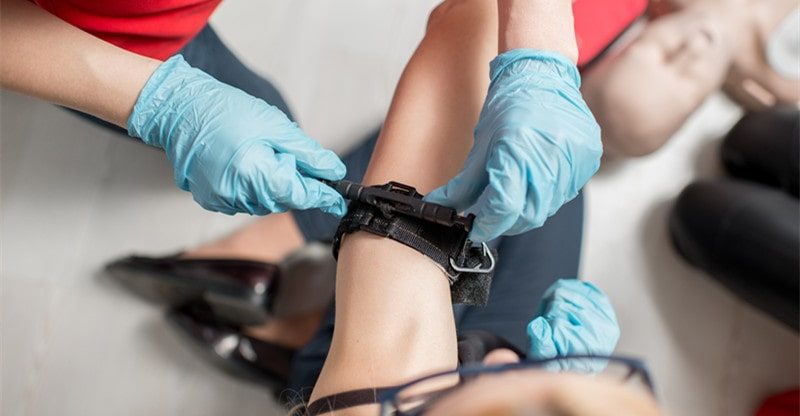Why A Sam Junctional Tourniquet Is A Workplace First Aid Must-Have
A first aid kit is essential in any given situation: from company workplaces where many people work simultaneously to households nationwide. Mishaps and injuries may take place at any given location and time; hence, preparedness is key.
Among the numerous methods out there to prepare for possible accidents include carrying a first aid kit in the workplace or at home at all times. It’s critical to guarantee that everyone has access to it to save lives in the event of an unforeseen emergency.
Tourniquets: A Commonly Forgotten Essential In A First Aid Kit
When determining what first aid equipment is required, the type of task performed in the workplace, as well as the geographical location of the workplace, are taken into account. Most of the time, the first aid kit would contain bandages, cleansing wipes, adhesive tapes, scissors, disposable gloves, and many more. However, one item is often overlooked—tourniquets.
A tourniquet is a device that applies pressure to a bleeding area to halt the blood flow. They function by constricting an artery’s blood flow. Although it’s a useful medical gear, many people, unfortunately, think it isn’t necessary to be included in a first aid kit.
On the bright side, products by Sam Medical and other internationally known emergency medical solutions brands are present to aid those who find tourniquets hard to use. They provide tourniquets that may be administered in less than 25 seconds, successfully control bleeding, and effectively immobilize pelvic fractures. Keep reading if you’re wondering why such equipment is vital in a workplace first aid kit.
3 Reasons To Keep A Sam Junctional Tourniquet In A Workplace First Aid Kit
Junctional injuries develop at the intersection of the spine, extremities, and neck. These injuries aren’t treatable with ordinary tourniquets and may be difficult to manage. Fortunately, junctional tourniquets were invented to bridge this gap.
The following are some of the uses for a junctional tourniquet:
1. Sam Junctional Tourniquet Can Be Tightened Firmly
It’s said that the most common reason for a poorly executed tourniquet application is slack. It’s a good thing that a Sam junctional tourniquet and the like have a buckle technology that auto-locks at a predefined amount of circumferential stress. This way, nearly all tourniquet slack will be eliminated. All you need to do is click, twist, and secure the equipment for an effective application.
2. It Comprises A Target Compression Device (TCD)
The target compression device (TCD) of Sam junctional tourniquet and others may be easily inflated using a detachable hand pump or just any Luer lock syringe. This helps in effectively reducing blood loss. In this manner, bilateral occlusion of blood flow is possible.
3. Sam Junctional Tourniquet Is Effective
The junctional tourniquet from companies like Sam Medical is unique in its design. It merely necessitates fewer modifications and continuously reduces application variance by anticipating windlass spins. As a result, no reports of harmful consequences have been recorded from those who tried using such junctional tourniquets.
How To Use A SAM Junctional Tourniquet
Indeed, the SAM junctional tourniquet provides efficient blood hemorrhage control in situations where a traditional tourniquet would be ineffective. It’s intended to treat axillary and groin hemorrhages, allowing users to recover patients in the workplace or other emergency scenarios.
To understand more about how this advanced product functions, here’s how you can correctly use it to control difficult bleeding in the axilla area, commonly referred to as the armpit area.
• Set the junctional tourniquet as high as feasible under the victim’s arms. Position the D-ring on the wounded side, connecting it with the neck’s side. Proceed by drawing the brown grips apart until you hear a clicking sound. This will connect the buckle and fasten the strap.
• Attach the tourniquet’s extender to the TCD before application, and then place the straps on the brown Velcro.
• Fasten the strap to the D-ring on the front of the junctional tourniquet using the large clasp.
• Attach the auxiliary strap to the cable on the rear of the junctional tourniquet using the little clasp. In this step, try to be as close to the patient’s mid-line as feasible.
• Using the brown handles, tighten the straps as much as needed. Inflate the TCD with the pump until the bleeding stops. Once the patient is about to be transported, keep an eye on the patient for bleeding control and modify the device as needed. To take the tourniquet off, simply unbuckle the belt.
Final Thoughts
Workplace-related mishaps and the like occur. Alas, personnel don’t know when they could happen. Thus, everyone must be prepared with the proper first aid gear in order to deal with these crises once they occur. One of the core components in emergencies is a tourniquet.
Tourniquets are used when a person is bleeding profusely. Such equipment is necessary to stop excessive blood flow so that the injured person won’t be placed in a situation that may jeopardize their chances of survival. Sam junctional tourniquet products, in particular, are fantastic because they perform an excellent job of aiding in the cessation of blood flow from certain injuries.




